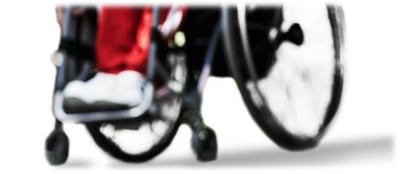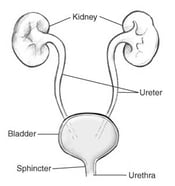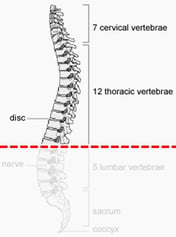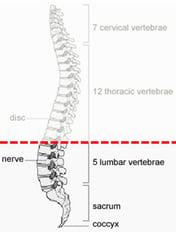When you see someone in a wheelchair, you notice the obvious – this person can’t walk. But that’s just one issue, and not even the highest ranking that most people with Spinal Cord Injury (SCI) must negotiate.
Very often bladder and bowel problems are ranked as bigger obstacles than the ability to walk.
Learn more about the connection between SCI and the bladder in this blog post.

The spinal cord
The spinal cord is about as thick as a finger and is very delicate. It lies in a fluid-filled canal in your backbone. The spinal cord sends and receives signals from your entire body. Thanks to these signals, we can move our arms, legs and other muscles in our body. These signals also control the body’s ability to empty the bladder and bowel.
Spinal cord injuries
The higher up in the spinal cord an injury occurs, the more muscles are affected. In the case of paraplegia, the spinal cord is so damaged that the legs are affected. In the case of tetraplegia, both arms and legs are affected.
Complete spinal cord damage means that the spinal cord has been completely cut off. No signal can travel along it, which means that all feeling and ability to move is gone below the point of injury.
If the damage is incomplete, you experience a certain loss of the ability to control your muscles. But some signals will still go through. If you have some motor control in your hands and arms, you will most likely be able to choose self-catheterization as a bladder emptying option.
Effects on your bladder
Simply p ut, the higher the injury is located, the more serious it may be
ut, the higher the injury is located, the more serious it may be
for your bladder condition.
This is due to loss of steering and control of urination from the brain,
and its centers.
High injury
An injury may cause something called detrusor-sphincter dyssenergia. 
This means that the bladder and sphincter are working against each other (see image of the urinary system above). The bladder contracts but the sphincter remains closed.
This is dangerous; as high pressure builds up in the bladder, urine is forced back up to the kidneys which can potentially destroy them. It also increases the risk of infection and incontinence.
First line treatment is to reduce bladder pressure with pharmaceuticals and emptying the bladder with Clean Intermittent Catheterization (CIC).
Low injury

If you have an injury lower in your spinal cord, you lose muscle tone in the
bladder and sphincter. With a complete injury the bladder muscle can’t contract.
However incomplete lesions are most common. And since only some
nerve fibers are affected, your urinary system may partly function.
A low spinal cord injury results in retention or incomplete emptying,
urinary tract infections and (overflow) incontinence.
First line treatment is CIC.
It is also worth mentioning that recent studies indicate that some of those who lose control of their bladder, may regain function again some time after injury.
Click below to learn more. You can watch Mick and Michael, both with spinal cord injuries, tell their story,
and also download a PDF about how spinal cord injuries affect the bladder.




